The major objective of cow-calf operations is to produce one calf per cow every year. Therefore, reproductive performance of the cowherd highly determines the efficiency and profitability of cow-calf systems.
Reproductive management of the herd involves many factors, such as the development of replacement heifers, postpartum interval and rebreeding of cows, and also management of gestation and delivery of the calf. To ensure that the reproductive performance of the herd is adequate, beef producers, farm crew and industry personnel should understand the fundamentals of reproduction in cattle.
This article will provide basic information regarding the anatomy and physiology of the cow’s reproductive system.
Anatomy
The cow reproductive tract is located in the pelvic and abdominal cavities. The major structures of the cow reproductive tract are the vulva, vagina, cervix, uterus, oviducts and ovaries (Figures 1 and 2). Some of their features and functions are:
- Vulva — External part of the reproductive tract. It consists of two labia (left and right) that form a closure to minimize the entrance of foreign material into the reproductive tract. The vulva becomes swollen when the cow is in heat or near calving.
- Vagina — Located between the vulva and the cervix. Approximately 8 inches long, it is the site of semen deposition during natural breeding, urine excretion and also serves as the birth canal during calving.
- Cervix — Located between vagina and the uterus. It is a unique, cylindrical structure within the reproductive tract, approximately 5 inches long and 2 inches in diameter. The body of the cervix typically contains three ridges (also known as cervical rings), which can be perceived by rectal palpation. The main function of the cervix is to isolate the uterus from the external environment. During heat, the cervix produces a significant amount of mucus, which lubricates the vagina for copulation and can be frequently observed as a clear and fluid discharge from the vulva. Throughout pregnancy, the cervical mucus becomes viscous and temporarily seals the cervix so that foreign materials do not harm the fetus.
- Uterus —The uterus consists of a body, which is anterior to the cervix and serves as the site for semen deposition during artificial insemination, and two horns. The uterus has many functions in the reproductive process. It is considered the “organ of the pregnancy” because the fetus will be housed, protected and nourished within this organ throughout pregnancy. Uterine walls are composed of several layers of contractile muscles and secretory glands, which aid in: 1) sperm viability and transportation to encounter and, hopefully, fertilize the egg; 2) expelling the fetus and fetal membranes during the calving process; and 3) synthesis of hormones that control the reproductive function of the cow, such as prostaglandin.
- Ovary —The ovary is an oval structure adjacent to each the uterine horn. Its primary function is to produce the egg, which is originated from blister-like structures called follicles. The ovary also produces hormones that control reproduction in the cow, such as estrogen and progesterone.
- Oviducts —Tubes that extend from each ovary to the respective uterine horn. Following ovulation, the egg is deposited into the oviduct, where it meets with sperm cells for fertilization.
Hormones and the estrous cycle
To better understand the reproductive system of cows, we first need to recognize the main hormones produced by the cow’s body to control reproduction. These are:
- GnRH — Gonadotropin releasing hormone. Synthesized by the hypothalamus in the brain, stimulates synthesis and release of LH and FSH by the pituitary gland, which is also located within the brain
- FSH — Follicle stimulating hormone. Responsible for initial development of follicles in the ovary.
- LH — Luteinizing hormone. Responsible for final development of follicles and consequent ovulation and formation of a corpus luteum (also known as yellow body or CL).
- Estrogen — Produced by follicles in the ovary. It is required for the ovulation process, triggers the estrus behavior (heat) in cows, and stimulates secretions and dilation of the cervix during heat and calving.
- Progesterone — Synthesized by the corpus luteum, which is formed in the ovary where the follicle releases the egg. Progesterone is known as the “pregnancy hormone” because its main function, if conception occurs, is to preserve the pregnancy and prevent new ovulations, by blocking GnRH synthesis by the brain.
- Prostaglandin — There are several types of prostaglandins produced within the body, but the one primarily associated with reproduction is prostaglandin-F2α. This hormone is produced by the uterus, and its main function is to cause regression of the corpus luteum if the cow did not become pregnant, ceasing progesterone production and allowing a new ovulation to occur. In pregnant cows, the fetus produces specific hormones that prevent prostaglandin production by the uterus; therefore the corpus luteum, progesterone production and pregnancy are maintained.
The reproductive system of cows is characterized by a series of physiological events that occur in a definite order over a specific period of time, which are classified as estrous cycles. The length of each estrous cycle averages 21 days, but can range from 17 to 24 days. The estrous cycle starts when the cow is in estrus and ends immediately prior to the next estrus. During the adult life, the estrous cycle is interrupted by pregnancy, recovery from calving and nursing, as well as malnutrition, stress and diseases.
In cycling cows, the estrous cycle can be divided into two phases (luteal and follicular; Figure 3). The luteal phase corresponds to 80% of the cycle (17–18 days), when progesterone production by the corpus luteum is elevated and follicle development within the ovaries is suppressed. The other 20% (4–5 days) consists of the follicular phase, when the corpus luteum is regressed, progesterone production is ceased, and follicular growth, estrogen and LH production are enhanced, resulting in estrus behavior and ovulation. Following egg release, the ovulated follicle changes into a new corpus luteum, and the luteal phase returns. If the cow does not become pregnant, the estrous cycle is repeated. If pregnancy occurs, the corpus luteum is maintained and the estrous cycles are interrupted.
The puberty process
Puberty is attained when the heifer expresses her first estrus behavior and ovulates a fertile egg.
The processes associated with the first ovulation are primarily regulated by the hormone LH. As soon as young heifers synthesize enough LH to trigger ovulation and produce a fertile egg, they become pubertal and capable of conceiving. Synthesis of LH is affected mainly by heifer age, body size and composition, and nutritional status. Therefore, these are the main factors determining puberty attainment in heifers.
Ovulation and fertilization
During the follicular phase, elevated estrogen concentrations trigger estrus behavior in cows and lead to the LH surge and consequent ovulation. Cows are considered in estrus when they stand to be ridden by other animals and therefore are sexually receptive. On average, the estrus period lasts 15 hours, but can range from 6 to 24 hours depending on the animal. Ovulation, the release of the egg from the follicle into the oviduct, occurs between 24 and 32 hours after the onset of estrus.
Therefore, according to the estrous cycle arrangement, including the luteal phase, follicular phase, estrus and ovulation, cows have the chance of becoming pregnant about every 21 days.
After natural breeding, sperm cells need to move through the cervix to reach the uterus. Sperm cells originated from artificial insemination are already deposited into the uterine body. In the uterus, sperm cells navigate toward both uterine horns, although the egg is typically produced by only one ovary during each ovulation. Once entering the oviduct and encountering the egg, sperm cells go through two maturation processes called “capacitation” and “acrosomal reaction,” which allow only one sperm cell to penetrate and fertilize the egg.
Following fertilization, the sperm cell and egg become one single structure called an embryo. Embryonic cells immediately begin to multiply, and the embryo starts to develop rapidly and migrates from the oviduct to the uterine horn. Approximately 15 days after fertilization, the embryo begins to secrete a hormone (interferon-tau) that will “warn” the cow that she is pregnant, blocking prostaglandin synthesis and preserving the corpus luteum and consequent progesterone synthesis. Approximately 20 days after fertilization, the embryo stops migrating and attaches to the uterus, where it continues to develop until gestation is completed.
Conclusions
Reproductive performance of the cowherd is one of the most important factors affecting the efficiency and profitability of cow-calf systems. The reproductive function of cows is based on estrous cycles, a dynamic process controlled by several hormones produced by different parts of the body. Understanding the mechanisms that control puberty, fertility, and maintenance of pregnancy will provide additional information and resources for cow-calf producers to enhance the reproductive performance of their operation.
References
Fanning et al., 2007. University of Florida — IFAS Extension.
Mathis, C. P., and R. Parker. In: Cow-Calf Management Guide, CL440.
Perry, G. 2004. South Dakota State University — Cooperative Extension Service.
Senger, P. L. 2003. Pathways to Pregnancy and Parturition. 2nd edition. Current Conceptions Inc. Pullman, WA.
This document is part of the Oregon State University Beef Cattle Library. Prior to acceptance, this document was anonymously reviewed by two experts in the area.

















